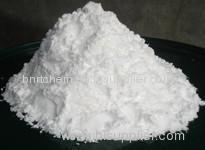Formula CH4N2 Density 1.02 g/cm³ | Molar mass 44.0559 g/mol Boiling point 36 °C | |
 | ||
Related compounds Appearance colourless crystalline solid | ||
Ammonium cyanide is an unstable inorganic compound with the formula NH4CN.
Contents
Uses
Ammonium cyanide is generally used in organic synthesis. Being unstable, it is not shipped or sold commercially.
Preparation
Ammonium cyanide is prepared in solution by bubbling hydrogen cyanide into aqueous ammonia at a low temperature
HCN + NH3(aq) → NH4CN(aq)It may be prepared by the reaction of calcium cyanide and ammonium carbonate:
Ca(CN)2 + (NH4)2CO3 → 2 NH4CN + CaCO3In dry state, ammonium cyanide is made by heating a mixture of potassium cyanide or potassium ferrocyanide with ammonium chloride and condensing the vapours into ammonium cyanide crystals:
KCN + NH4Cl → NH4CN + KClReactions
Ammonium cyanide decomposes to ammonia and hydrogen cyanide, often forming a black polymer of hydrogen cyanide:
NH4CN → NH3 + HCNIt undergoes double decomposition reactions in solution with a number of metal salts.
It reacts with glyoxal, producing glycine (aminoacetic acid):
NH4CN + (CHO)2 → NH2CH2COOH + HCNReactions with ketones yield aminonitriles, as in the first step of the Strecker amino acid synthesis:
NH4CN + CH3COCH3 → (CH3)2C(NH2)CN + H2OToxicity
The solid or its solution is highly toxic. Ingestion can cause death. Exposure to the solid can be harmful as it decomposes to highly toxic hydrogen cyanide and ammonia.
Chemical analysis
Elemental composition: H 9.15%, C 27.23%, N 63.55%.
Ammonium cyanide may be analyzed by heating the salt and trapping the decomposed products: hydrogen cyanide and ammonia in water at low temperatures. The aqueous solution is analyzed for cyanide ion by silver nitrate titrimetric method or an ion-selective electrode method, and ammonia is measured by titration or electrode technique.
